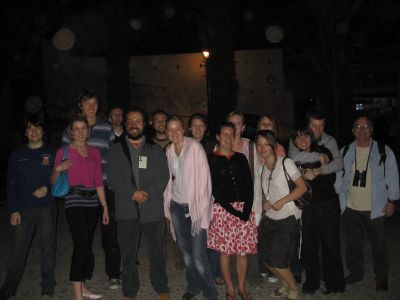Seville study trip diary: day one
Early on a wintry March morning, 38 students and staff from the Department of Sociology [led by Cecily Jones and Hazel Rice) left behind the windswept Warwick campus and for set off for southern Spain. Four hours later, still tired and sleep-deprived, we arrived at our destination, the city of Sevilla. Emerging bleary-eyed from the airport, we were all immensely cheered to find a city of orange trees, palms and sunshine, in stark contrast to the miserable weather we’d left behind in the UK – the first sun most of us had seen in months! I think we all considered this a good omen for the trip.
 And our visit did get off to a good start, once we’d identified the
correct coach to take us to the hotel. On our first evening, we split up into
groups to explore the city, although arriving on a Sunday afternoon at the
beginning of the Christian festival of Lent, many of the attractions and shops
were closed, except for Burger King, of course, where some students had their
first taste of Spanish cuisine. Some of
us, however, had the equally bizarre experience of dining in a Spanish Chinese
restaurant. As none of us could understand the baffling Spanish menu, we were
fortunate in having Amy Evans on hand. Amy recognised the obscure Chinese
dialect the staff were speaking, and ensured that everyone got the meal they
wanted – just about.
And our visit did get off to a good start, once we’d identified the
correct coach to take us to the hotel. On our first evening, we split up into
groups to explore the city, although arriving on a Sunday afternoon at the
beginning of the Christian festival of Lent, many of the attractions and shops
were closed, except for Burger King, of course, where some students had their
first taste of Spanish cuisine. Some of
us, however, had the equally bizarre experience of dining in a Spanish Chinese
restaurant. As none of us could understand the baffling Spanish menu, we were
fortunate in having Amy Evans on hand. Amy recognised the obscure Chinese
dialect the staff were speaking, and ensured that everyone got the meal they
wanted – just about.
WHY SEVILLA?
Sevilla is the capital city of Andalusia, the southernmost part of Spain, and generally acknowledged to be the most quintessentially Spanish region. It’s the fourth biggest city in Spain, described by Byron, chauvinistically, as ‘a, pleasant city, famous for its oranges and women”, but as we were to find, it offers far more than this; in fact it has a wealth of culture, a vibrant nightlife and a zest for living, as demonstrated by the locals’ passion for festivals and flamenco.
The region has over 3,000 years of history and the city itself is literally a living museum. Unlike previous years, we did not have any formal study, as efforts to persuade the Sociology Department at the University of Sevilla to organise lectures for us proved unsuccessful. Still, students and staff alike found that Sevilla’s rich and fascinating heritage offered an education in Spanish history. Though we only spent a total of two and a half days in the city, most agreed that it was a great choice for the visit. One student summed up the city as ‘simply magical!’
